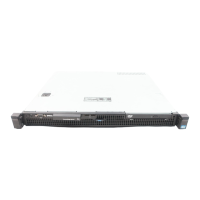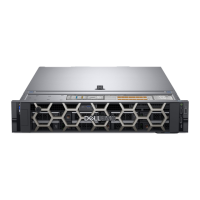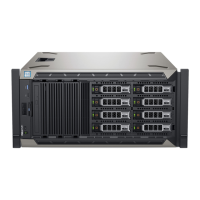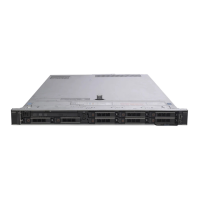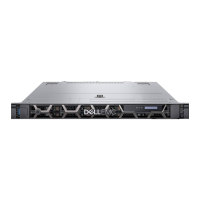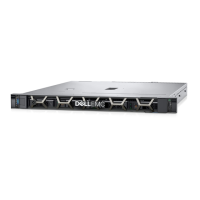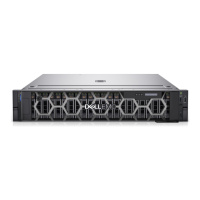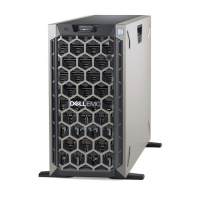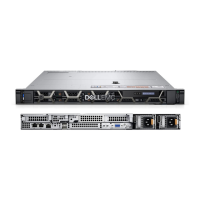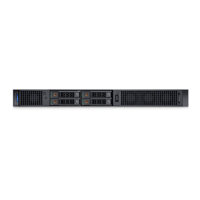Do you have a question about the Dell PowerEdge E31S Series and is the answer not in the manual?
Details supported hardware configurations for the server.
Overview of components and features on the server's front panel.
Overview of components and features on the server's back panel.
Explains system indicators for operation and error status.
Describes indicator patterns for hard drive status and activity.
Describes indicator patterns for uSATA SSD status and activity.
Explains network interface card indicators for activity and link status.
Details indicator codes for AC and DC power supply units.
Explains LED indicators for iDRAC Direct activity.
Describes indicator codes for Quick Sync status and activity.
Instructions on how to find the system's service tag.
Describes the physical dimensions of the server chassis.
Details the weight of the system with different drive configurations.
Specifies the supported Intel Xeon processor families.
Details specifications for AC and DC power supply units.
Specifies the type of system battery used.
Details PCI Express expansion card slot specifications.
Covers supported DIMM types, speeds, and capacities.
Lists supported hard drive options and types.
Details specifications for USB, NIC, serial, and VGA ports.
Lists supported video resolutions and color depths.
Outlines temperature, humidity, vibration, and altitude specifications.
Step-by-step instructions for unpacking and setting up the server.
Information on configuring the Integrated Dell Remote Access Controller.
Methods and resources for installing the server's operating system.
Explains how to download necessary system firmware and drivers.
Lists available tools for pre-OS system management.
Accesses BIOS settings, iDRAC, and device configurations.
Provides advanced embedded system management capabilities.
Allows selection of boot options and diagnostic utilities.
Enables booting and configuring networked systems remotely.
Crucial safety guidelines to follow before performing component replacements.
Covers prerequisites, post-procedure steps, and recommended tools.
Procedures for removing/installing front bezel and information tag.
Steps for removing and installing the system cover.
Covers system layout, cooling shroud, fans, and fan assembly.
Details supported memory types, installation, and configurations.
Procedures for removing and installing processors and heat sinks.
Covers PCIe holder, retention bracket, controller card, and expansion cards/risers.
Covers IDSDM, NDC, USB key, HDD/SSD, backplane, tape backup, optical drive, SD card.
Covers system battery, PSUs, and DC power wiring.
Procedures for removing/installing system board and TPM module.
Covers drive blanks, hot-swappable drives, carriers, backplanes.
Procedures for removing and installing the control panel assembly.
Details the Enhanced Pre-boot System Assessment (ePSA) diagnostics.
Steps to launch diagnostics from Boot Manager.
Steps to launch diagnostics from the Lifecycle Controller.
Explains the controls available within the system diagnostics utility.
Explains the function of system board jumpers.
Identifies and describes system board connectors and jumpers.
Procedure to disable system and setup passwords using a jumper.
Addresses issues related to system startup failures.
Guides on troubleshooting issues with external device connections.
Steps to troubleshoot issues with the video output.
Steps for troubleshooting problems with USB devices.
Guides for troubleshooting iDRAC Direct USB XML and laptop connections.
Steps for troubleshooting serial port devices.
Guides on troubleshooting Network Interface Card issues.
Procedure for troubleshooting system damage due to liquid exposure.
Steps for troubleshooting general system damage.
Addresses issues related to the system battery.
Guides on troubleshooting power source and PSU problems.
Addresses cooling problems and specific fan troubleshooting.
Guides on troubleshooting system memory (RAM) issues.
Guides on troubleshooting USB keys and micro SD cards.
Guides on troubleshooting optical drives and tape backup units.
Addresses troubleshooting drives, SSDs, and storage controllers.
Guides on troubleshooting expansion card issues.
Steps for troubleshooting processor issues.
Information on understanding system messages like warnings and alerts.
Information on how to contact Dell EMC for support and service.
Instructions on how to provide feedback on the documentation.
How to use the Quick Resource Locator (QRL) for system information.
Details supported hardware configurations for the server.
Overview of components and features on the server's front panel.
Overview of components and features on the server's back panel.
Explains system indicators for operation and error status.
Describes indicator patterns for hard drive status and activity.
Describes indicator patterns for uSATA SSD status and activity.
Explains network interface card indicators for activity and link status.
Details indicator codes for AC and DC power supply units.
Explains LED indicators for iDRAC Direct activity.
Describes indicator codes for Quick Sync status and activity.
Instructions on how to find the system's service tag.
Describes the physical dimensions of the server chassis.
Details the weight of the system with different drive configurations.
Specifies the supported Intel Xeon processor families.
Details specifications for AC and DC power supply units.
Specifies the type of system battery used.
Details PCI Express expansion card slot specifications.
Covers supported DIMM types, speeds, and capacities.
Lists supported hard drive options and types.
Details specifications for USB, NIC, serial, and VGA ports.
Lists supported video resolutions and color depths.
Outlines temperature, humidity, vibration, and altitude specifications.
Step-by-step instructions for unpacking and setting up the server.
Information on configuring the Integrated Dell Remote Access Controller.
Methods and resources for installing the server's operating system.
Explains how to download necessary system firmware and drivers.
Lists available tools for pre-OS system management.
Accesses BIOS settings, iDRAC, and device configurations.
Provides advanced embedded system management capabilities.
Allows selection of boot options and diagnostic utilities.
Enables booting and configuring networked systems remotely.
Crucial safety guidelines to follow before performing component replacements.
Covers prerequisites, post-procedure steps, and recommended tools.
Procedures for removing/installing front bezel and information tag.
Steps for removing and installing the system cover.
Covers system layout, cooling shroud, fans, and fan assembly.
Details supported memory types, installation, and configurations.
Procedures for removing and installing processors and heat sinks.
Covers PCIe holder, retention bracket, controller card, and expansion cards/risers.
Covers IDSDM, NDC, USB key, HDD/SSD, backplane, tape backup, optical drive, SD card.
Covers system battery, PSUs, and DC power wiring.
Procedures for removing/installing system board and TPM module.
Covers drive blanks, hot-swappable drives, carriers, backplanes.
Procedures for removing and installing the control panel assembly.
Details the Enhanced Pre-boot System Assessment (ePSA) diagnostics.
Steps to launch diagnostics from Boot Manager.
Steps to launch diagnostics from the Lifecycle Controller.
Explains the controls available within the system diagnostics utility.
Explains the function of system board jumpers.
Identifies and describes system board connectors and jumpers.
Procedure to disable system and setup passwords using a jumper.
Addresses issues related to system startup failures.
Guides on troubleshooting issues with external device connections.
Steps to troubleshoot issues with the video output.
Steps for troubleshooting problems with USB devices.
Guides for troubleshooting iDRAC Direct USB XML and laptop connections.
Steps for troubleshooting serial port devices.
Guides on troubleshooting Network Interface Card issues.
Procedure for troubleshooting system damage due to liquid exposure.
Steps for troubleshooting general system damage.
Addresses issues related to the system battery.
Guides on troubleshooting power source and PSU problems.
Addresses cooling problems and specific fan troubleshooting.
Guides on troubleshooting system memory (RAM) issues.
Guides on troubleshooting USB keys and micro SD cards.
Guides on troubleshooting optical drives and tape backup units.
Addresses troubleshooting drives, SSDs, and storage controllers.
Guides on troubleshooting expansion card issues.
Steps for troubleshooting processor issues.
Information on understanding system messages like warnings and alerts.
Information on how to contact Dell EMC for support and service.
Instructions on how to provide feedback on the documentation.
How to use the Quick Resource Locator (QRL) for system information.
